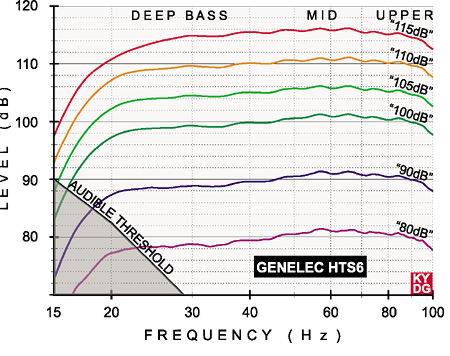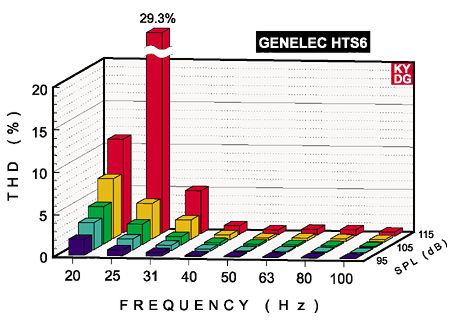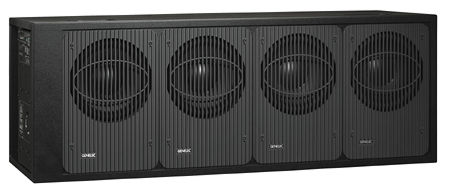Way Down Deep I Genelec HTS6
"Those guys must have 120 employees. I'll bet 118 of 'em have Ph.D.s. The other two have masters', and they answer the phones." He shook his head. "With horsepower like that, all stuck in the middle of the tundra, there's no way you're gonna turn out mediocre-sounding speakers."
We were standing in the aisle at an AES convention. My engineer friend was referring to Genelec, one of his biggest competitors. Headquartered about six hours outside of Helsinki, Finland, in the general direction of the North Pole, Genelec has indeed become a leading force—some would say the dominant force—in the world of high-end studio monitoring.
The largest subwoofer in this survey, the HTS6 is a residential version of Genelec's reference studio unit, the 7073A. There's no veneer here, rosewood or otherwise, no fabric grilles, no eye candy of any type. The HTS6 is as austere as an Arctic winter. And with its four 12-inch, individually powered drivers, it heated up this subwoofer shootout like no other.
Measurements
Frequency response at 80dB (Fig.13): 20–100Hz, +/-2.2dB; -5.6dB at 18Hz.

Fig. 13: Frequency Response vs Output
Frequency response at higher levels: The Genelec HTS6 met its rated frequency response at all playback levels, up to and including 110dB at 1m. At the nominal 115dB level, fitting the measured response required opening the tolerance window only very slightly, to +/-3.2dB. The manufacturer's +/-3dB spec was met from 24Hz to 100Hz even at a run-for-cover 120dB. Importantly, up to 115dB, the individual response traces show the same shape, suggesting that the tonal balance should remain stable across an extreme range of playback volumes. Consistent with impressive dynamic behavior, the individual traces are offset vertically at what appear to be almost exactly 5 and 10dB increments.
Dynamic range: The above results are reinforced in the power compression graph (Fig.14), which reveals that, from 25Hz up, response at the higher playback levels, including 115dB, never deviated by more than +/-1dB of the 90dB baseline response. Expanding the response down to the 15Hz test limit requires an exceptionally narrow +1.0/–1.6dB window. This is the cleanest dynamic behavior I've ever tested.

Fig. 14: Power Compression
Results of the Linkwitz shaped tone-burst tests (Fig.15) show that the HTS6 registered the highest undistorted peak output levels of the dozen contenders at all frequencies, typically by 5–6dB over the next best performer.

Fig. 15: Shaped Tone-burst Peak Output
Total harmonic distortion: The THD bar chart (Fig.16) reveals unusually clean behavior overall, with logged values of <1% above 32Hz at all playback levels. A solitary anomaly occurred at 25Hz at the highest (115dB) playback level, where THD registered 29.2%. The otherwise exemplary test results were buttressed by listening to the sinewave sweeps, which remained subjectively pristine to below 20Hz at all playback levels—a welcome contrast to the fuzzy, hashy, ragged character most other subs exhibited to one degree or another at the higher playback levels.

Fig. 16: Total Harmonic Distortion vs Frequency & Leve
The Finnish flagship was also free of cabinet squeaks, groans, rattles, buzzes, hisses, and hums. Simply resting my hand on the cabinet during high-level sinewave sweeps suggested an unusually low level of vibration. Since vibrations turn cabinet panels into lo-fi "speakers," it's possible that panel-launched energy will add to the driver's direct output in ways that audibly degrade timbral and/or temporal performance.
This spurred me to attach a Brüel & Kjær accelerometer at various locations on the cabinet to "listen" for and measure cabinet chatter on the HTS6 and several other units. The accelerometer confirmed that the Finnish unit's cabinet was much less active than the others I tested. Although, in and of itself, this may not confer a clear audible advantage, it is, at the very least, evidence that an unusual level of care was exercised in the Genelec's design, materials selection, and assembly.
Listening
On the "Jurassic Lunch" cut from Telarc's Great Fantasy Adventure Album, the scale of the terror is set by the animal's size, which is conveyed by how heavily he treads the ground. That final clomp at 1:02 (Figs.A1 and A5) produced an air shudder around me, a gripping throb of energy that strangely lacked the telltale accompaniments—fluttering, groaning, wheezing, scraping—that would have otherwise disclosed the source to be a subwoofer.

Intrigued by how deep and eerily clean that clomp came across, I left the main speakers disconnected and advanced the volume to find the point at which the HTS6 hit the wall. It turned out to be 120.5dB (measured at 2m, C weighting, fast), some 17–20dB higher than the other three subs in this installment, and more than 6dB higher than the next highest result among all the subs in this survey. The Genelec's substantially greater peak output on this track will not be directly relevant to the reader unless his/her room approaches the size of a commercial cinema: in even the grandest residential settings, turning up the playback system loud enough to approach the HTS6's limit would result in blown main speakers long before the HTS6 runs out of steam. Not to mention one's ears—or those movie-evening guests and nearby neighbors running screaming into the night—TJN
The depth charges beginning about 80 minutes into U-571 create physical shocks strong enough to blow the sailors into ragged heaps like so many damp, grimy rags in a hurricane. A glance at the reference waterfall I took directly from the surround processor's sub-output jack (Fig.B1) shows enough recorded energy throughout the 10–25Hz region to make it clear that the filmmakers intended the audience to not just see the chaos and fear, but to feel it, too. Of course, as noted earlier, in a typical commercial movie theater, they won't—TJN The HTS6 delivered big here (Fig. B5), fostering a palpable sense that the depth charges—concussive and deeply physical—were actually twisting and compressing the vessel's hull to the point where its structural collapse seemed seconds away. In terms of an audience experience, this was a difference not just of quantity but of kind: Switching to other subs left me missing more than deep, explosive bass, they left me missing the sense of participation and, with it, the feeling of doom in the gut.
With Japanese planes and torpedoes devastating the Pearl Harbor fleet, Cuba Gooding, Jr.'s character straps himself into harness at an antiaircraft gun station and sets his jaw. The barrage he unleashes is badly aimed—he's a cook, not a gunner—but a check of the waterfall plot (Fig.D1) shows the main stripe at 25–35Hz to be supplemented by a ridge at a sternum-flexing 15Hz, evidence that the filmmaker intended for the weapon to offer some hope of exacting a price, of blasting some of those brazen Zeros out of the sky—which is exactly what happens when our hero gets the hang of the hardware.
It would be interesting to experience this passage with a subwoofer able to play the 15Hz content as recorded; none of the dozen subs in this survey could manage it, including the Genelec. What the HTS6 did manage was to produce between 6 and 20dB more subjectively undistorted output than any other sub throughout the 18Hz-and-up range (Fig.D5). As with the U-571 track, it was more an issue of quality than of quantity. Disconnecting the main speakers and just listening to the sub dish out the barrage revealed none of the fuzzy, muffling, loose, cardboardy distortion or scrunched-down dynamics I heard on almost all other subs as they approached their limits on this track. When the Genelec approached its limit (namely, 120dB, measured, as always, with C weighting, fast, at 2m), it didn't telegraph distress by distorting, it simply stopped getting louder. This is itself a clue of the design team's priorities: fidelity over raw output.
The passage I selected from Black Hawk Down is notorious among subwoofer enthusiasts. Known as the "F'ing Irene" scene, it begins with that expletive and cuts to the troops scrambling across the tarmac and into the choppers, which are just spinning up. To a subwoofer, that half-minute of engine and blade drones are what put the hell in helicopter. As shown by the waterfall plot's two leftmost stripes, at 7 and 18Hz (Fig.C1), both infrasonic elements are recorded "hotter" than the more playable 30, 42, and 55Hz components. The 7Hz component may be an unintended artifact of the recording process—no recording studio or dubbing stage I've been in has subs that can hope to reach down that far, meaning engineers wouldn't have a way to monitor it; they may not even know it's there. Or it may have been deliberately included as a challenge: "Here, you audio wonks, let's see you try this!"
The 18Hz stripe is a different matter, as it lies just within the compass of half a dozen or more of the best subs available. In any case, the rumble lodges in the gut, introducing an undertone of danger and possible tragedy to an otherwise gung-ho scene. The emotional pitch varied from sub to sub as a function of how capably each could deal with the 18Hz gut-tragedy element. By now it should come as no surprise that the Genelec handled this passage with the deepest low-end reach, lowest distortion, and highest level of any sub in the survey, which directly translated into the most gripping movie experience.
On music, the exposed bass-drum strokes in "March of the Exorcists," from the Casper soundtrack, were solid, believable, and, most of all, effortlessly clean. Turned up to realistic levels, the Holst bass-drum whack and the cannon blasts in Tchaikovsky's 1812 Overture mustered more you-are-there believability than any other sub in the survey.
But throttling back the level by 5–10dB made it tough (often impossible) to tell the HTS6 and several other subs apart on these music tracks. Likewise, the tunnel explosion in The Phantom Menace was rendered immaculately, but not noticeably better than what I heard with a few other top-performing subs. The same with The Matrix mid-air chopper explosion, and the "Flight of the Cosmic Hippo" and "Jersey Girl" CD tracks. (If you have trouble believing that subs of different sizes, driver configurations, amplifier capabilities, cabinet makeup, countries of origin, and prices could possibly sound alike on challenging material, just take them outside, away from walls and the standing waves they create, match the levels, and listen for yourself.)
The Bottom Line
The Genelec was the largest specimen in this survey, so one might have expected big output from it—and it delivered, typically generating 6–10dB more undistorted level than its closest rivals, and 15–20dB more than the smaller units in the survey. But the surprise was that the hulking HTS6 consistently outperformed the pack in subtle ways as well. It sounded cleaner at all playback levels, almost irrespective of what I fed it—test tones, music selections, soundtracks, special effects.
Over the months of this survey, I periodically returned to my core test clips to see if maybe the sense of being in the movie, as opposed to at the movies, could be summoned as effortlessly and inexorably by any other sub. It never happened. I combed through Internet postings, Netflix, and the local Blockbuster, looking for a DVD to cut it down to size. I never found one. I rifled through my 1500 CDs to try to find a passage to cause it to stumble, if only just a little; to see if another sub could edge it out on that track. I came up empty. Not only could I not humble the Genelec, I couldn't elicit a rattle, chuff, flutter, or other acknowledgment that it was even breaking a sweat. I couldn't get it to heat up and shut down after hours of sweeps, pulses, and sundry punishments that sent 40 acres of wildlife scrambling for the high country. A cool character, this arctic behemoth. Very cool.
Specifications
Genelec HTS6 magnetically shielded, port-loaded, powered subwoofer in cabinet of MDF (2" thick baffle, 1" thick elsewhere)
Drivers: four 12" Nomex-pulp, long-throw cones
Frequency response: 19–120Hz, +/-3dB
Inputs: RCA (single-ended), XLR (balanced)
Amplifiers: four @ 250W, heatsinking via cast-aluminum driver grilles
Lowpass filter: 120Hz, 36dB/octave, nondefeatable
Phase: 0°, –90°, –180°, –270° (selectable)
Other: 20Hz adjustable shelving filter for room-gain compensation; fixed infrasonic filter at 19Hz (18dB/octave)
Weight: 265 lbs
Dimensions: 57" x 21" x 22" (WxHxD)
Finish: black
Price: $9950
Genelec, Inc.
(508) 652-0900
www.genelecusa.com
- Log in or register to post comments






























































